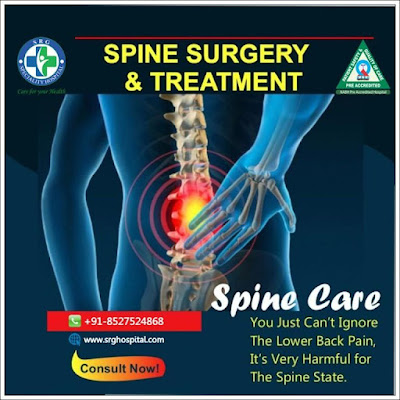Most Popular Spine Surgery Procedure By Spine Surgeon in Delhi
Spine surgery is frequently a great way to ease pain and get back to
daily activities for many patients who are suffering from a spinal issue.
Patients must be thoroughly evaluated and informed of their treatment
choices by a skilled orthopaedic spine surgeon before to having surgery.
Understanding the facts is a crucial first step on the road to recovery because
any surgery can be frightening.
I'll go over
the most popular kinds of spine surgery in this section.
The two types of spine procedures that are performed most frequently are
those that stabilise the spine and those that decompress the neurological
structures. During spinal surgeries, the categories are frequently combined.
More specifically, four popular procedures account for nearly 90% of all spine
surgeries. These are as follows: Check: Spine Surgeon in Delhi
Discectomy: In this treatment,
herniated disc material that is pressing on the spinal cord or nerves is often
removed. A decompressive procedure is a discectomy.
Laminectomy /
laminotomy: This procedure creates an aperture over the spinal cord or nerve to
release pressure on those structures. The words laminectomy and laminotomy
describe where and how big the opening is in the posterior portions of the
spine. Another kind of decompression is this one. Check: Spine Surgeon in Delhi
Spinal
Decompression And Fusion: This procedure, which is the most popular spine surgery India,
stabilises the spine by relieving pressure on "pinched" nerves and/or
the spinal cord. Using hardware that is anchored to bony components of the
spine, pressure is released during the surgery, and the spine is stabilised.
Spine stabilisation and decompression are combined in this surgery. Check: Spine
Specialist In New Delhi
Anterior
Cervical Discectomy And Fusion: In a way, this is a spinal decompression and fusion procedure. The
difference is that it is performed from the front of the spine, as opposed to
the most common decompression and fusion procedures, which are generally
performed from the back. It has earned a separate position on this list because
it is very commonly performed. Indications include nerves or the spinal cord
pinching in the cervical spine.
Anterior Cervical
Discectomy And Fusion: In a sense, this technique is similar to spinal decompression and
fusion. The difference between it with the most popular decompression and
fusion operations, which are typically conducted from the back of the spine, is
that it is carried out from the front of the spine. Moreover, as implied by the
name, it is done on the neck. Because it is so frequently done, it has earned a
special spot on this list. Nerves or the spinal cord that are pinched in the
cervical spine are indicators.
The neurological structures in this region of the spine are susceptible
to compression caused by the disc, so we remove the disc, restore the disc
space by inserting a spacer between the vertebrae, and use instrumentation to
hasten the process of the vertebrae joining together, or "fusing,"
together. Another treatment that combines spinal stabilisation and
decompression is this one. Check: Spine Specialist In New Delhi
Problems
Associated with the Most Popular Spine Surgery Types
In general, the following conditions are linked to spine surgery:
A herniated
disc
Cervical and lumbar spine spondylosis, which is essentially an
accumulation of degenerative abnormalities in the spine
Cervical myelopathy, in which the patient's ability to walk is
compromised due to pressure on the cervical spinal cord. Spondylosis and this
condition frequently go hand in hand.
Spondylolisthesis, or vertebral slippage over one another.
Spine surgery
objectives
The immediate objectives of the surgery might be categorised into one of
the following groups depending on the ailment the surgeon is treating:
• The decompression of neural tissue.
• Spinal stabilisation
• The simultaneous decompression of spinal segments and stability of
neurological structures.
Our long-term objective for spine surgery is to lessen pain and improve
patients' function.
Common
Falsehoods
The two most prevalent myths are that spine procedures are risky or pose
a significant risk of long-term neurological damage. The danger of the
aforementioned problems is relatively minimal, and hundreds of thousands of
spine procedures are safely performed each year in the India.
Another myth is that after surgery, the patient's ability to function
will be severely constrained. As I previously stated, the aim of surgery is to
enhance rather than restrict patient function.
Also, some patients think it doesn't matter who does the procedure. For
your surgery, it's crucial to collaborate with a qualified and seasoned
orthopaedic spine surgeon.
The Value of
Spine Surgery Qualification
The vast majority of patients who have met the necessary criteria for
spine surgery get very good to outstanding outcomes, return to normal or almost
normal function, and experience a significant reduction in pain.
In general, the few patients who experience negative outcomes were
frequently not properly qualified and were probably not excellent candidates
for surgery in the first place.
The recovery
process is constantly evolving.
We are continually advocating for advancements in spine surgery, such as
less invasive surgical techniques and improved pain management for patients
having spine surgeries. The time it takes to recover from a spine operation is
substantially less than it used to be, and that trend will only continue.
Depending on the procedure, we usually anticipate patients to resume
their regular activities in three weeks or less. Some individuals who have less
invasive procedures say they are able to resume their normal activities within
a few days and without any pain.
The following guidelines are particular to recovery from lumbar fusion
surgery.
Further information on how to get ready for spinal surgery is available
here.








Comments
Post a Comment